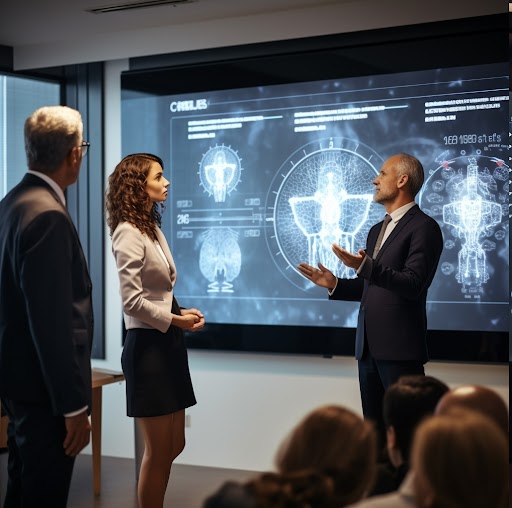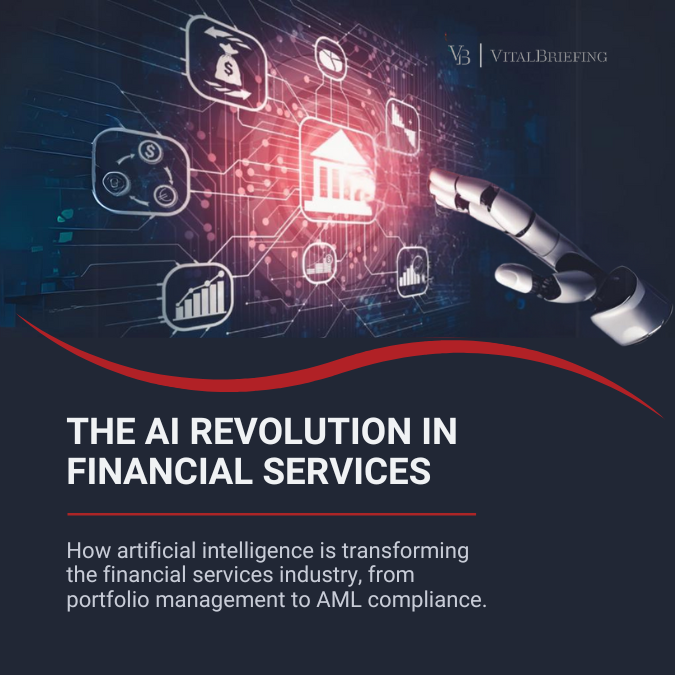Chronicle of the “GenAI: Ready to tackle tomorrow?” conference by Deloitte[1]
A Prelude to Tomorrow’s Odyssey
Generative AI (GenAI), the latest frontier in artificial intelligence, transcends traditional data analysis to create diverse content like text, images, and codes. At the Disrupted/Disrupter Conference, hosted by the Luxembourg House of Financial Technology (LHoFT) and organised by Deloitte Luxembourg, Nicolas Griedlich, AI and Data Leader at Deloitte, emphasised GenAI’s role as a transformative and all-encompassing tech. He noted its capacity to revolutionise various sectors and its position among disruptive technologies like autonomous systems and quantum computing.
With significant adoption across Europe – over half of the companies evaluating and 20% investing in GenAI – its influence is expanding. GenAI is enhancing the capabilities of developers and optimising workflows, not replacing human roles. However, challenges such as model hallucinations, privacy issues, adversarial behaviour, and ethical dilemmas accompany its growth, highlighting the need for careful navigation of this evolving landscape.
The Cogs of Progress in Business
Dr. Jochen Papenbrock from NVIDIA highlights GenAI’s transformative role in the financial sector, making everyone a potential researcher or coder through Large Language Models[2] (LLM). GenAI is revolutionising various financial functions like wealth management, fraud detection, and marketing. Its applications extend from regulatory compliance to market analysis, using specialised data sets to train LLMs for tasks like fraud predictions. NVIDIA is advancing in simulation technology, creating digital twins for climate analysis[3], aiding in asset risk management for insurance and investment.
GenAI’s adoption marks a shift from traditional Central Processing Units[4] (CPUs) to more powerful Graphics Processing Units[5] (GPUs), enhancing computing power and efficiency in data centres. This shift enables complex data integration with LLMs, improving database interaction and real-time response capabilities in financial services. Luxembourg, with its advanced infrastructure like the Meluxina[6] supercomputer, is poised to become a future financial hub, leveraging GenAI for data-driven innovation.
Ethical Paradoxes in GenAI
Dr. Thomas Metzinger from the Gutenberg Research College of Mainz critiqued the ‘Ethics Washing’ in GenAI, particularly targeting the European Commission’s ethics guidelines for trustworthy AI[7], which he found profoundly disappointing. He criticised these guidelines for glossing over real issues, ignoring long-term risks, and feigning certainty. Metzinger highlighted the challenges in achieving rational, evidence-based public debate, distorted by sensationalist journalism and industry lobbying, and the spread of Technology Evangelism.
Referencing Thilo Hagendorf’s research, “The Ethics of AI Ethics: An Evaluation of Guidelines”[8], Metzinger underscored a significant gap between ethical guidelines’ aspirational principles and their practical application in AI development. He argued for transforming AI technology from a private good to a well-protected common good[9] for humanity. Concluding, Metzinger emphasised the need for a balanced approach in GenAI utilisation, considering ethical implications to avoid damaging reputations.
Much could be said about this powerful and instructive speech, and it will be the subject of a later article devoted to his academic position on artificial consciousness and the risks associated with such a breakthrough.
Through the Legal Labyrinth
Silvia A. Carretta, Chief Legal Officer of Women in AI, highlighted the legal challenges of GenAI, including privacy violations, IP rights infringements, and labour market shifts. Notably, technologies like ChatGPT, when faced with “attack prompts”, pose risks like data leaks, reputational damage, and perpetuation of biases.
As GenAI evolves, so does the EU’s regulatory framework. The 2018 General Data Protection Regulation[10] (GDPR), with its focus on data rights and processing principles, contrasts with AI’s data needs. The 2019 Digital Single Market Directive[11] addresses GenAI’s copyright risks, while the proposed AI Act[12] aims to add more transparency and content moderation safeguards.
Companies using GenAI must navigate these regulations, monitoring territorial and licensing restrictions, open-source software incorporation, and data ownership. They should also prepare for the AI Act, focusing on AI-generated content disclosure, high-risk AI system evaluations, and illegal content generation bans. Upcoming regulatory discussions will further address sensitive business aspects, like source code access, and set standards for model testing and data governance.
The AI Pact[13], a Commission initiative, encourages early adoption of AI Act principles, holding industry players accountable. Additionally, the proposed Directive on AI Liability seeks to establish a unified liability regime for AI-caused damage in the EU.
Conclusion: Postscript from the Future
This impressive array of experts and informed speeches on the realities of GenAI and its impact on our society calls for in-depth reflection while taking care not to fall into the trap denounced by Dr Thomas Metzinger – rhetoric devoid of any practical bearing on technical practice. Leveraging ground-breaking cloud capabilities to use existing LLMs or emulate quantum computing bears exciting promises for companies in the financial sector; but financial market players also bear a huge responsibility towards regulators, supervisory authorities, investors and retail clients. In this age of fast-paced technological race, and despite the heat of this acceleration, one would be wise not to overlook the necessary considerations of ethics and respect for the law, the very foundations of a solid AI strategy. Quoting the International Monetary Fund’s recent Report[14] on the adoption of GenAI in financial services, GenAI technology shows “great promise” in the financial sector, as long as we understand, and avoid downplaying, the very real risks intrinsic to this revolutionary technology.
Featured image source : Midjourney
[1] Official link to the event: https://www2.deloitte.com/lu/en/events/events/2023/disrupted-disrupter.html
[2] “A large language model (LLM) is a specialised type of artificial intelligence (AI) that has been trained on vast amounts of text to understand existing content and generate original content.” Source: https://www.gartner.com/en/information-technology/glossary/large-language-models-llm
[3] Earth-2, NVIDIA’s Digital Earth Twin, trains and applies AI weather models through their open-source platform Modulus and provide early access to a range of AI weather models. Official website: https://www.nvidia.com/en-us/high-performance-computing/earth-2/
[4] “Primary component of a computer that processes instructions. It runs the operating system and applications, constantly receiving input from the user or active software programs. It processes the data and produces output, which may be stored by an application or displayed on the screen.” Source: https://techterms.com/definition/cpu
[5] GPUs have evolved to become fundamental to AI and high-performance computing. Initially, they were designed for rendering 3D graphics, but their architecture, optimised for parallel processing, makes them highly efficient for complex, repetitive computations like those in machine learning and deep learning. More information here: https://developers.redhat.com/articles/2022/11/21/why-gpus-are-essential-computing#:~:text=Graphics%20processing%20units%20,facial%20recognition%20into%20mainstream%20technology
[6] https://luxembourg.public.lu/fr/investir/innovation/meluxina-superordinateur.html
[7] Ethics Guidelines 1.0, published April 11, 2019; Policy and Investment Recommendations, published June 26, 2019.
[8] In open access here: https://link.springer.com/article/10.1007/s11023-020-09517-8
[9] “Towards a Global Artificial Intelligence Charter”. In European Parliament (Ed.), “Should we fear artificial intelligence?”; in The Cambridge Handbook of Responsible Artificial Intelligence. Cambridge University Press. By Metzinger, T.
[10] https://eur-lex.europa.eu/legal-content/EN/TXT/?uri=CELEX%3A02016R0679-20160504
[11] https://eur-lex.europa.eu/eli/dir/2019/790/oj
[12] “Artificial intelligence act: Council and Parliament strike a deal on the first rules for AI in the world” – European Council Press Releases https://www.consilium.europa.eu/en/press/press-releases/2023/12/09/artificial-intelligence-act-council-and-parliament-strike-a-deal-on-the-first-worldwide-rules-for-ai/
[13] https://digital-strategy.ec.europa.eu/en/policies/ai-pact
[14] https://www.imf.org/en/Publications/fintech-notes/Issues/2023/08/18/Generative-Artificial-Intelligence-in-Finance-Risk-Considerations-537570

